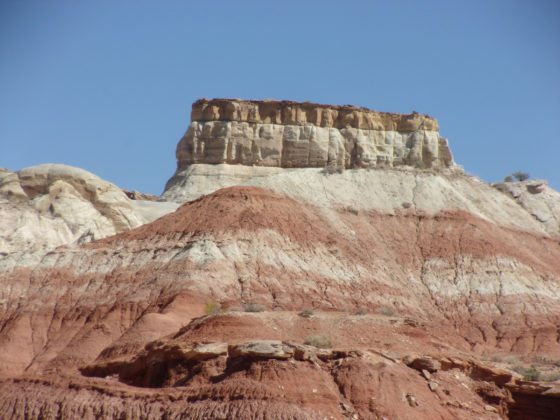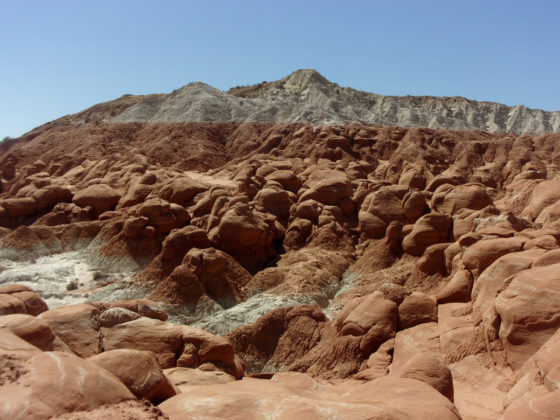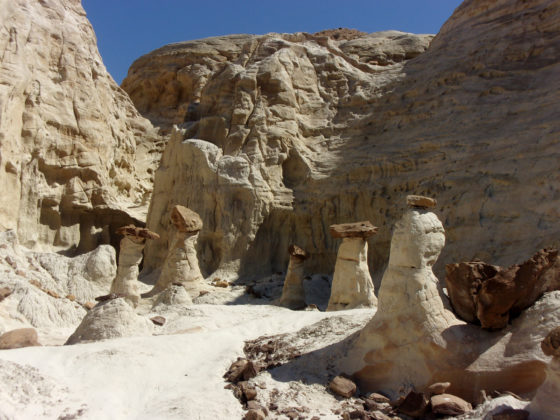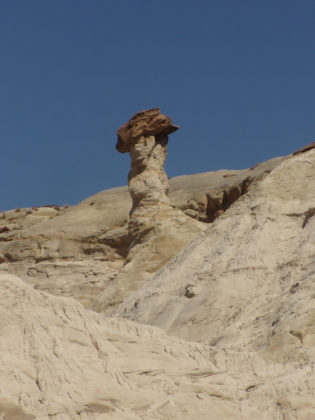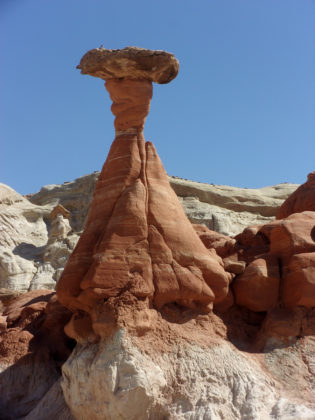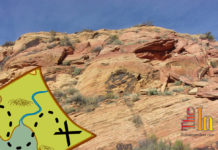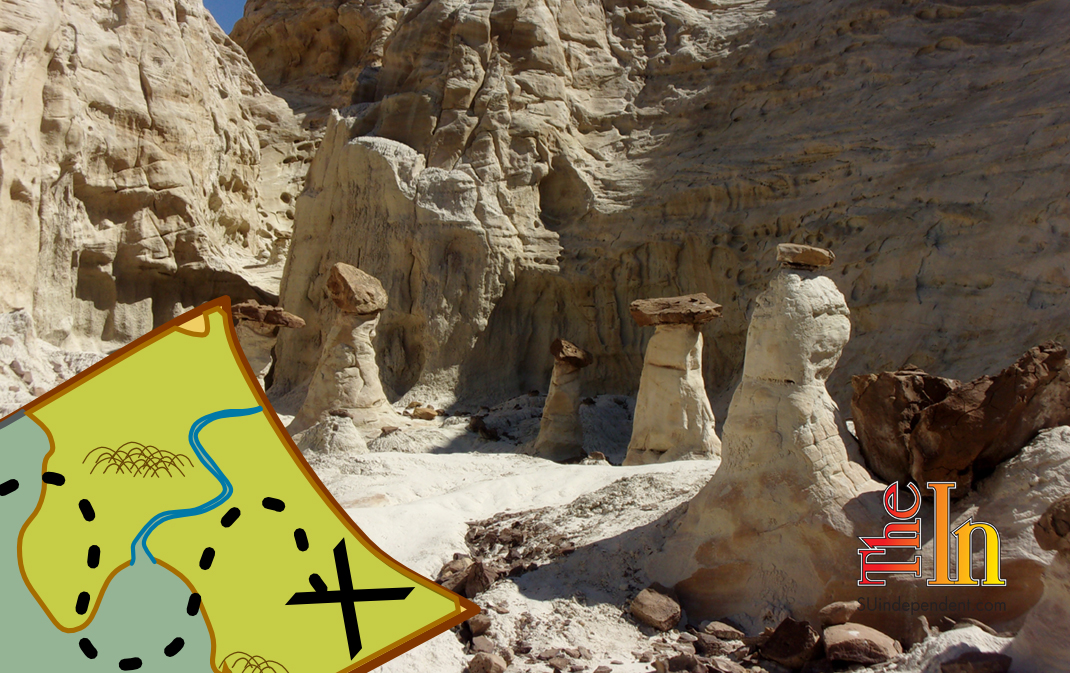
Hiking Southern Utah: Kanab’s Toadstools Are Cool
by Tom Garrison
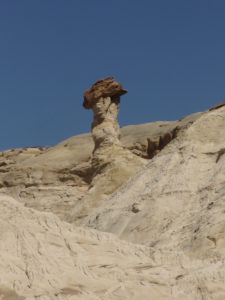
A toadstool is a fungus with an umbrella-shaped top that is often poisonous. Not for me or thee. There is, however, a type of toadstool (aka hoodoos, goblins, mushrooms, and rimrocks) that everyone should experience.
So what is this marvelous toadstool? It is a spire-like rock formation with a hard, usually flatish, boulder atop the pedestal resembling a toadstool or mushroom. It forms when softer rock erodes, leaving a column sheltered from some erosional effects by a cap of harder rock — a pinnacle with a rock cap. Toadstools range in height from about three feet to more than 30 feet tall. Like toadstools, these formations seem to have sprouted from the earth. While these rock toadstools are not to be ingested, visiting them is a magical experience.
The toadstools are found near the southern boundary of the Grand Staircase-Escalante National Monument. The monument, encompassing nearly 1.9 million acres of south central Utah, is the largest national monument in the United States. It is unique in that it is the first monument to be administered by the Bureau of Land Management rather than the National Park Service. The remote and pristine monument preserves a wealth of flora and fauna and ancestral Puebloan (Anasazi) artifacts and home sites, not to mention a geological sampler with a huge variety of formations and features. Approximately 1,000 miles of roads, mostly dirt, provide public access to the many jewels of this area.
Our outing began in late April. Our troop included me and Deb. Bob and Molly, our cats, decided that afternoon nap time was more important and did not make the trip. Leaving St. George, we went through Hurricane on Highway 9 and then on to Fredonia, Arizona via Highway 59 (Highway 389 in Arizona). In Fredonia, we turned left (north) onto Alternate Highway 89 and a few miles later entered Kanab — which means “place of willows” in Paiute. This leg of the trip is approximately 75 miles depending upon your starting point in St. George. You can also get to Kanab through Zion National Park via Highway 9 east and then Highway 89 south. While it is a bit shorter, the drive takes longer due to park traffic, and you must pay the $30 per vehicle entrance fee.
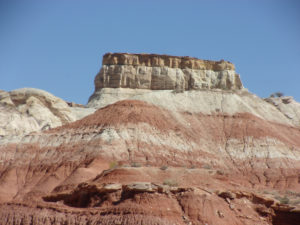
In Kanab, at the intersection of Alternate Highway 89 and Highway 89, set your trip odometer to zero, turn right, and continue east on Highway 89. At 44.3 miles from the intersection and between mileposts 20 and 19 — or 1.5 miles past the turnoff to the Grand Staircase-Escalante National Monument ranger station — turn left (north) into the signed small parking area and trailhead kiosk. No water is available, so be sure to bring at least two liters of water per person for a day hike.
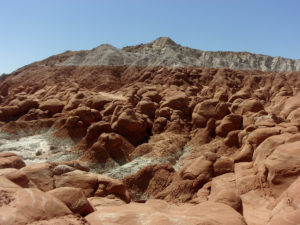
No permits are necessary, and there is no fee for day hiking. The trailhead elevation is 4,380 feet, and only a slight elevation change of approximately 120 feet makes this an easy hike. The temperature was in the mid-80s, and the sky was a deep Utah blue as we embarked. Our adventure lasted less than two hours, almost 2.5 miles roundtrip.
We went through a hiker’s gate and followed the well-marked trail north alongside, and sometimes in, a wash as rock spires became visible ahead. There, the trail climbs into some whiteish badlands.

At 0.75 miles in, we approached the iconic “Red Toadstool,” a conical spire that tapers to a point and then widens a bit with a large red rock perched on the apex. There’s no way that toadstool should have survived millennia while being pummeled by thunderstorms with raging rain and wind — but there it was.
Behind the Red Toadstool were several others, three to 20 feet tall, closer to the white cliffs. After exploring this area, we walked west (left when facing the white cliffs) on the red Entrada Sandstone bench around a point. All around were peaks and mounds with abrupt color changes between white and reddish brown.
After about a quarter of a mile, we entered a land of pearly white toadstools. In one section up against the white cliffs was a small forest of five white pinnacles, all with red caps. A little further west, we stood on a cliff top and admired the magnificent views of a wide multi-hued valley. We retraced our steps and returned to the trailhead.
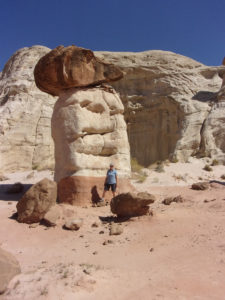
We greatly enjoyed this hike, and so will you. Do remember that many of the toadstools are fragile. Do not climb or deface them in any way. Let’s make sure future generations can enjoy these amazing rock structures.
We ended the day with a stop at the Cowboy Butte Grill and Steakhouse at 165 N. Main St. in Fredonia for some well-deserved grub and liquid refreshments.
The toadstool area is a land of hard-to-believe balanced rock formations — an otherworldly place to explore and enjoy. It an easy hike for the entire family into a wonderland displaying the power and whimsy of erosion.

